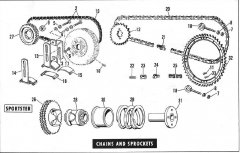I’m in a camp similar to ‘mdt-son’, where he suggested above that short gear life is in part due due to a quality issue with the gears. Possibly the result of the wrong alloy steel, the wrong heat treatment or both. It is certainly possible to make a high quality gear for this application that exhibits long wear life. And there are certainly gears similar to the common Norton gears made for other marques that exhibit the same sort of premature spalling gear wear we’re discussing here.
Just thinking out loud about gear hardness, perhaps a manufacturer is putting 0.020” to 0.030” of case hardening on the gear, when in fact it requires 0.050” for long term survival. The gear will always have a soft ‘under belly’ beneath the hardened surface, and perhaps if the case is not thick enough, the hard surface incrementally deflects into the softer underbelly and over the course of time small ruptures of the case occur and result in the spalling type wear pattern we see? If this is actually happening, I don’t think we can lubricate your way around such an issue.
Earlier in this thread the subject of HD and common oil in primary and tranny came up. Tying the subjects of common primary/tranny oil and high quality gears together, consider the gears Andrews makes for Harley Sportsters (read the description of the product on the right page [4 speed] at the link below, and turn the page if you want to read a little more about their products).
https://rssd.cld.bz/Andrews-Products-Catalogue/28/
Andrews simply makes the best products on state-of-the-art equipment and they perform stellar – you simply cannot buy a better gear for a HD Sportster. I’ve intentionally steered the conversation off target here (from Norton to HD) to make the case that readily available very high quality gears (that don’t spall) exist for specific marques, and feel confident that if Andrews were manufacturing Norton gearbox innards we wouldn’t be having this conversation. I hope that CNW’s gear undertaking results in a product of similar quality to Andrews, and leaves the issue of spalled gear faces behind.
In closing want to add that the HD Sportster gear box/primary drive performs just fine with ATF (Dexron II, no spalling type wear), although the factory always recommended oil, and suspect that oil would, in the final analysis, ultimately result in less wear over extremely long use cycles. The majority of teams campaigning HD XRs (same 4-speed gearbox used in Sportster since 1957, but with 90+ HP) in flat track racing also employed ATF in the gear boxes and tranny with no wear concerns (admittedly this is not a high mileage use, but is nevertheless a brutal short-term use). And by the way, for many decades Sportsters never had any form of cush-drive or compensator sprocket, yet the gears held up fine. My $0.02.



